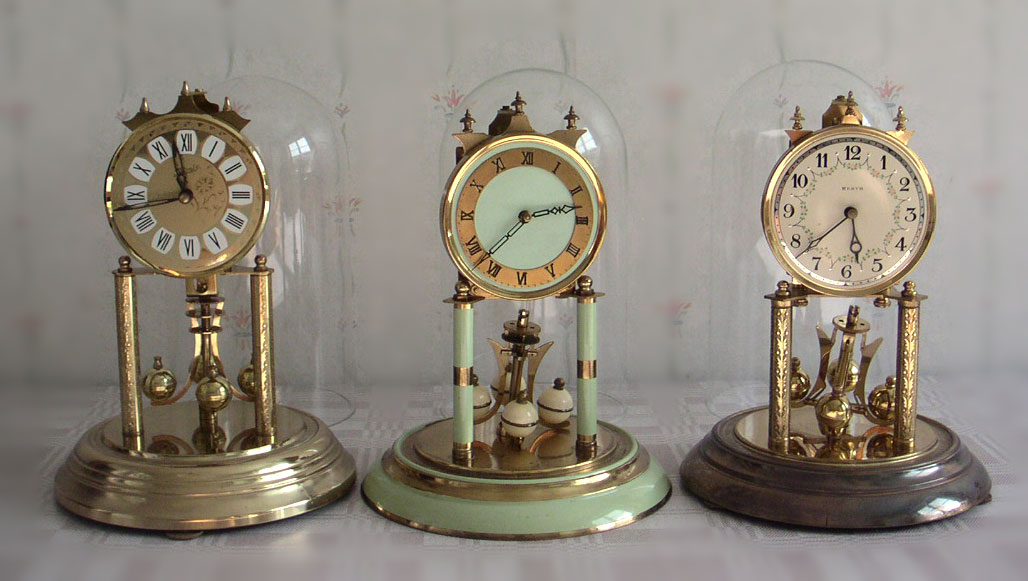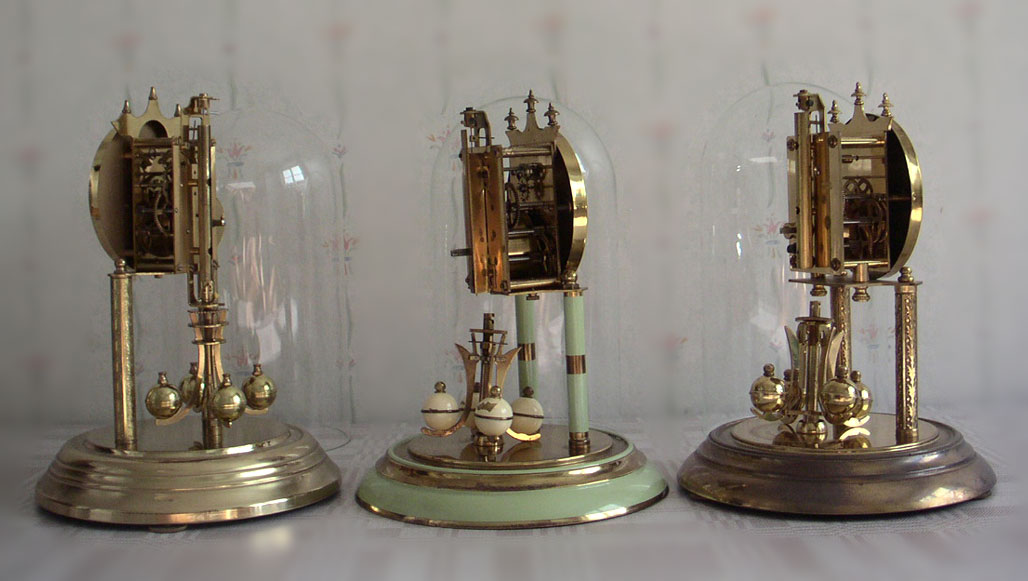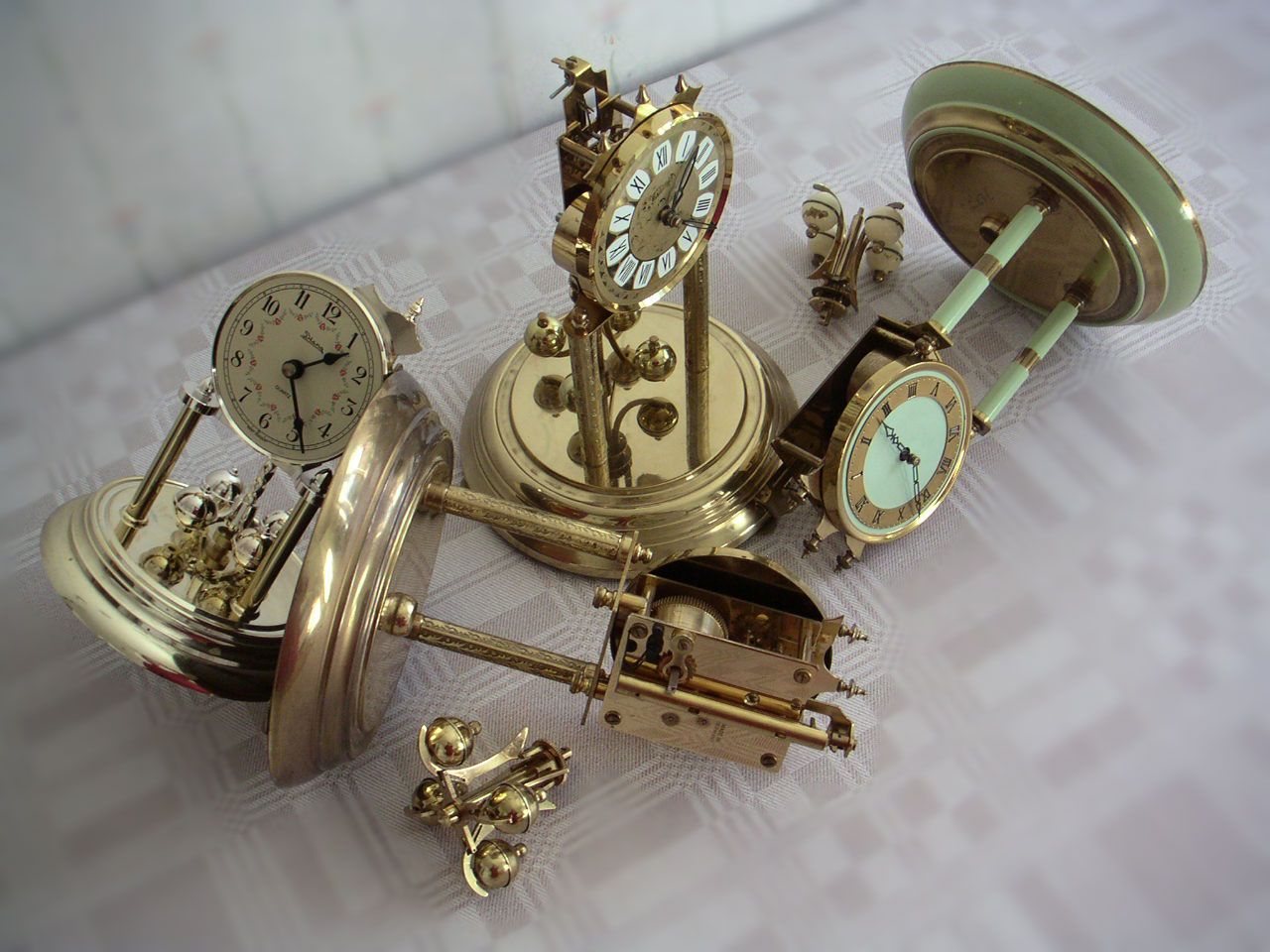Click on the images to make them even larger.
It looks like the anniversary clocks are scattered around but I have carefully placed them on the kitchen table and I took a photo with my digital camera. I have even got the glass dome for every clock -- except for the little Diana with the broken crown in the far left, which is mostly made of plastic and has a plastic dome. The Diana is there to make balance in the still life, the other 400 day clocks are made of metal.
The 400 day clock standing in the middle is a german Tissnis probably from the 1960:s, the clock lying in the middle is a German Hervo probably from the 1950:s and the clock lying on the right is made of W. Petersen in Schwenningen, Germany, probably in the 1930:s. Every 400 day clock without adjustement feet under the base is a pre-World War II clock. The only clocks running is the Diana and the Tissnis. The not shown dial of the Hervo is similar to the dial of the Diana. The cream-white colour of the W. Petersen ball pendulum is coming off in flakes, due to that the previous owner had the backside of that clock exposed to the sun under a long time with the pendulum not running. The Hervo got a crack in the base and in two balls of the torsion pendulum. Both W. Petersen and Hervo got broken suspension spring and the lower block missing. The suspension spring of the Diana is also broken, but that clock is different to the others: it's a quartz clock running on batteries ...
To see the wallpaper in its natural size, just click on the image. To download it, just right-click and save!

The Tissnis anniversary clock to the left, the W. Petersen, Schwenningen,
in the middle and the Hervo to the right.

The backside of the Tissnis torsion pendulum clock to the left, the W.
Petersen, Schwenningen, in the middle and the Hervo to the right.

The side of the Tissnis ball pendulum clock to the left, the W. Petersen,
Schwenningen, in the middle and the Hervo to the right.
It is permitted to everyone to do a partial or complete reproduction of this text and these images for non-commercial use.
If you like 400-day clocks, take a look at
the NAWCC message board here
or the australian clock site here
or the brand new American Horologist message board here.
Here is also instructions
how to use a 400-day clock.
Tranibor, I think you have it backwards. Your first clock was NOT made by Tissnis, it was made by S. Haller for Tissnis. The second clock was NOT made by Hervo, it was made by Georg Wurthner for Hervo. It was very common for both S. Haller and Georg Wurthner to make clocks for third parties. Both companies are well documented to have produced 400-Day clocks both for their own market as well as to sell to others. For example: * Haller made clocks for HECO (Henry Coehler), Robanne Corp., Hamilton HYL and others. * Wurthner made clocks for John Wanamaker, H. Eule, H.X.M. and others. Almost all of the post-WW2 makers sold movements and complete clocks to third parties, most of them "branded" with the reseller's name. The most prolific maker for third parties was Kieninger & Obergfell (Kundo); others included Uhrenfabrik Herr, Edgar Henn, M. Reiner, Konrad Mauch (KOMA), Kern & S�hne, Hermle, Schatz, Uhrenfabrik Neueck, etc. Neither Tissnis or Hervo were ever recorded to have made any 400-Day clocks, my research indicates both were resellers. John Hubby
Borim Luneshar, October 14, 2006 (updated September 23, 2007)
Back to Destroyed
Timepieces
Back to The Time Machine models

